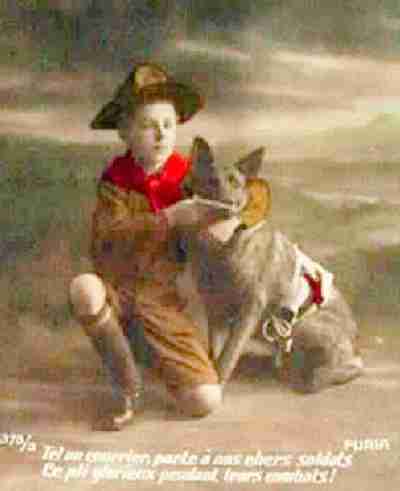
Boys' Historical Uniform Headwear: Campaign Hats

Figure 1.--I believe this is a French Scout during World War I. Like most early Scout groups, they adopted the same hat worn by British Scouts. This is a French postcard which were commonly used as we now do greeting cards. Children were one of the popular subjects on these cards.
|
The Scouts of course adopted the famed wide-brimmed campaign hats for early uniforms. It was afopted by Lord Baden Powell for the first English Scoy uniform and American and most European Scouts also adopted it. British Scouts often refer to it as the lemon-squeezer hat. The term Smokey Bear hat is a modern American term, refering to a bear cub that survived a forest fire and was adopted by American park rangers. I'm not sure what term was used for it in other countries. Probably no single type of headwear is more associated with a youth group than the Smokey Bear hat is associated with Scouting. The only youth group to wear this hat was the Scouts. Like most of the headgear adopted by youth groups, it was originally a military style. It was worn by Baden-Powell and special scout formations in the British Army which is why it was initially chosen for British Scouting. American soldiers in the early 20th century, however, did wear it. It looks more American than British because it was the standard issue U.S. Army hat in the Spanish American War and more importantly World War I. It was the most widely worn Scout headgear until World War II. Some Scout groups adopted more natioanl headgdear, but most opted for the traditional hat. It was only in the 1940s during and after World War II that most Scout groupsd adopted new headwear. Most early European Scout groups adopted this hat. It was one of the few actual hats worn by youth groups--most of which used less formal caps. There are, however, a few traditional groups that still wear these hats.
Origins
The Scouts of course adopted the famed Smokey Bear hats for early uniforms. It was afopted by Lord Baden Powell for the first English Scout uniform and American and most European Scouts also adopted it. Like most of the headgear adopted by youth groups, it was originally a military style. It was worn by Baden-Powell and special scout formations in the British Army which is why it was initially chosen for British Scouting. It looks more American than British, based on the Stetson hat of the American West. I assumed the originl inspiration was American. One source, however, that thge inspiration was the Canadian hats during the Boer War. The hat style so impressed Baden Powell that he adopted it for his new Boy Scouts." While regular British soldiers did not wear it, American soldiers in the early 20th century did wear it. it was the standard issue U.S. Army hat in the Spanish American War and more importantly World War I. American soldies were still wearing it in 1939 when World War II broke out in Europe. A British reader suggests, "BP formulated many of his ideas [HBU notes at the least the ones he did not appropriate from Seaton] on scouting and bushcraft while stationed in South Africa with the British Army. Most likely he wore that style of hat there. It would have been useful to protect the head and eyes from the bright sunlight when out on the veldt. I
think that the scout scarve also originated in South Africa."
Terminology
The proper term for the wide-brimmed Scout hat is "campaign hat". English Scouts often refer to it as the lemon-squeezer hat. The term Smokey Bear hat is a modern American term, refering to a bear cub that survived a forest fire and was adopted by American park rangers. It also became popularly associated with state highway troopers (policemen) in the United States. A reader notes we used the Smokey the Bear term on a page about English Scouts in the 1920s, "Smokey the Bear didn't come along until the 1940s, so it is anachronistic
to refer to his hat when discussing Scouts before the in the 1920s. Besides, "Smokey Bear hat" is US-centric, and "lemon squeezer hat" would be more generally understood by an
international audience."
Symbol of Scouting
Probably no single type of headwear is more associated with a youth group than the Smokey Bear hat is associated with Scouting. The only youth group to wear this hat was the Scouts.
The hat was made of felt. It had a wide brim with an indented crown, rather looking like a cowboy hat. It also had a chin strap. This basic style has remained unchanged since it was adopted by Baden Powell in the 1900s.
Chronology
The campaign hat was the most widely worn Scout headgear until World War II. It was commonly worn in most countries both before and after World War I. Even German Scouts wore the hat, before and after World War I, despite its association with British Scouts and American soldiers. But it was widely worn by other Scouts around the world. Some Scout groups adopted more natioanl headgdear, but most opted for the traditional hat. It was only in the 1940s during and after World War II that most Scout groupsd adopted new headwear. Most early European Scout groups adopted this hat. It was one of the few actual hats worn by youth groups--most of which used less formal caps. There are, however, a few traditional groups that still wear these hats.
HBU

Navigate the Historic Boys' Uniform Web Site:
[Return to the main headwear page]
[Activities]
[Biographies]
[Chronologies]
[Countries]
[Essays]
[Garments]
[Organizations]
[Religion]
[Other]
[Introduction]
[Bibliographies]
[Contributions]
[FAQs]
[Questions]
[Unknown images]
[Boys' Uniform Home]
Navigate the Historic Boys' Uniform Web chronological pages:
[1900s]
[1910s]
[1920s]
[1930s]
[1940s]
[1950s]
[1960s]
[1970s]
[1980s]
[1990s]
Created: May 17, 2000
Last updated: 3:42 AM 7/14/2005



